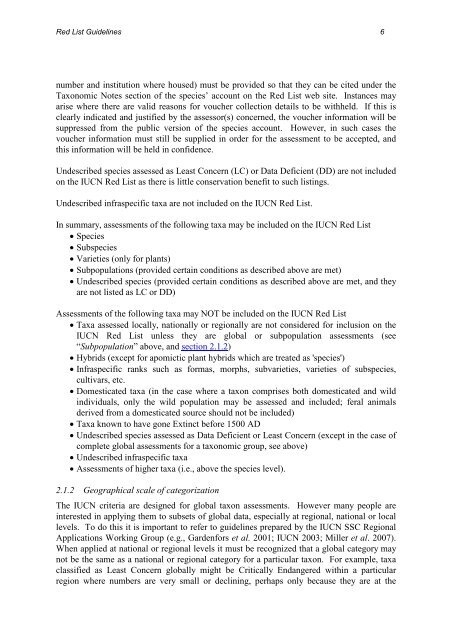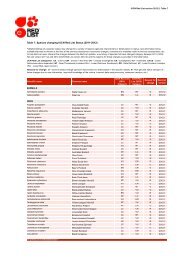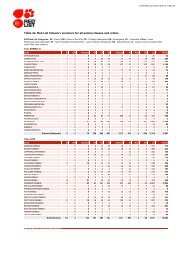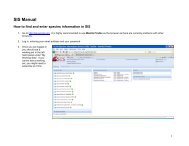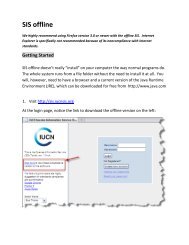IUCN Red List Guidelines - The IUCN Red List of Threatened Species
IUCN Red List Guidelines - The IUCN Red List of Threatened Species
IUCN Red List Guidelines - The IUCN Red List of Threatened Species
You also want an ePaper? Increase the reach of your titles
YUMPU automatically turns print PDFs into web optimized ePapers that Google loves.
<strong>Red</strong> <strong>List</strong> <strong>Guidelines</strong> 6<br />
number and institution where housed) must be provided so that they can be cited under the<br />
Taxonomic Notes section <strong>of</strong> the species’ account on the <strong>Red</strong> <strong>List</strong> web site. Instances may<br />
arise where there are valid reasons for voucher collection details to be withheld. If this is<br />
clearly indicated and justified by the assessor(s) concerned, the voucher information will be<br />
suppressed from the public version <strong>of</strong> the species account. However, in such cases the<br />
voucher information must still be supplied in order for the assessment to be accepted, and<br />
this information will be held in confidence.<br />
Undescribed species assessed as Least Concern (LC) or Data Deficient (DD) are not included<br />
on the <strong>IUCN</strong> <strong>Red</strong> <strong>List</strong> as there is little conservation benefit to such listings.<br />
Undescribed infraspecific taxa are not included on the <strong>IUCN</strong> <strong>Red</strong> <strong>List</strong>.<br />
In summary, assessments <strong>of</strong> the following taxa may be included on the <strong>IUCN</strong> <strong>Red</strong> <strong>List</strong><br />
• <strong>Species</strong><br />
• Subspecies<br />
• Varieties (only for plants)<br />
• Subpopulations (provided certain conditions as described above are met)<br />
• Undescribed species (provided certain conditions as described above are met, and they<br />
are not listed as LC or DD)<br />
Assessments <strong>of</strong> the following taxa may NOT be included on the <strong>IUCN</strong> <strong>Red</strong> <strong>List</strong><br />
• Taxa assessed locally, nationally or regionally are not considered for inclusion on the<br />
<strong>IUCN</strong> <strong>Red</strong> <strong>List</strong> unless they are global or subpopulation assessments (see<br />
“Subpopulation” above, and section 2.1.2)<br />
• Hybrids (except for apomictic plant hybrids which are treated as 'species')<br />
• Infraspecific ranks such as formas, morphs, subvarieties, varieties <strong>of</strong> subspecies,<br />
cultivars, etc.<br />
• Domesticated taxa (in the case where a taxon comprises both domesticated and wild<br />
individuals, only the wild population may be assessed and included; feral animals<br />
derived from a domesticated source should not be included)<br />
• Taxa known to have gone Extinct before 1500 AD<br />
• Undescribed species assessed as Data Deficient or Least Concern (except in the case <strong>of</strong><br />
complete global assessments for a taxonomic group, see above)<br />
• Undescribed infraspecific taxa<br />
• Assessments <strong>of</strong> higher taxa (i.e., above the species level).<br />
2.1.2 Geographical scale <strong>of</strong> categorization<br />
<strong>The</strong> <strong>IUCN</strong> criteria are designed for global taxon assessments. However many people are<br />
interested in applying them to subsets <strong>of</strong> global data, especially at regional, national or local<br />
levels. To do this it is important to refer to guidelines prepared by the <strong>IUCN</strong> SSC Regional<br />
Applications Working Group (e.g., Gardenfors et al. 2001; <strong>IUCN</strong> 2003; Miller et al. 2007).<br />
When applied at national or regional levels it must be recognized that a global category may<br />
not be the same as a national or regional category for a particular taxon. For example, taxa<br />
classified as Least Concern globally might be Critically Endangered within a particular<br />
region where numbers are very small or declining, perhaps only because they are at the


